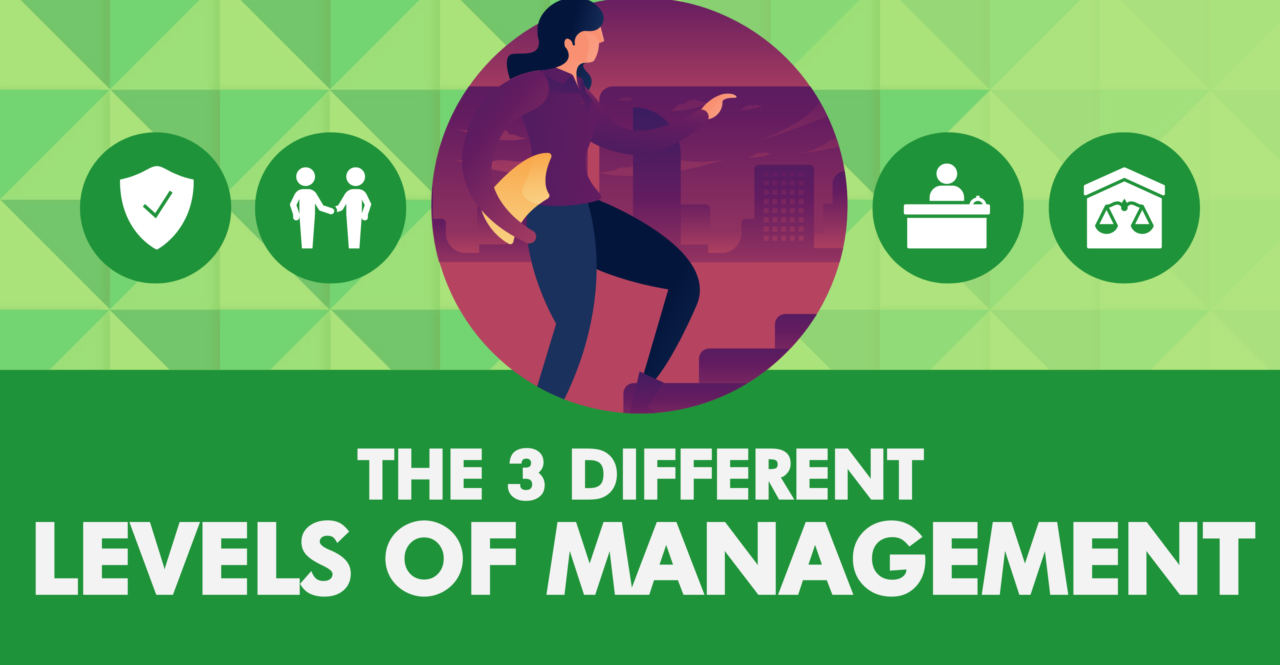
The 3 Different Levels of Management
Levels of Management
The term Levels of Management refers to the line of division that exists between various managerial positions in an organization. As the size of the company and workforce increases, the number of levels in management increases along with it, and vice versa. The different Levels of Management can determine the chain of command within an organization, as well as the amount of authority and typically decision-making influence accrued by all managerial positions.
Levels of Management can be generally classified into three principal categories, all of which direct managers to perform different functions.
In this article, we will explore the specific definition of these levels, as well as the roles and responsibilities of the managers that fall into these categories.
1. Administrative, Managerial, or Top Level of Management
This level of management consists of an organization’s board of directors and the chief executive or managing director. It is the ultimate source of power and authority, since it oversees the goals, policies, and procedures of a company. Their main priority is on the strategic planning and execution of the overall business success.
The roles and responsibilities of the top level of management can be summarized as follows:
- Laying down the objectives and broad policies of the business enterprise.
- Issuing necessary instructions for the preparation of department-specific budgets, schedules, procedures, etc.
- Preparing strategic plans and policies for the organization.
- Appointing the executives for middle-level management, i.e. departmental managers.
- Establishing controls of all organizational departments.
- Since it consists of the Board of Directors, the top management level is also responsible for communicating with the outside world and is held accountable towards an organization’s shareholders for the performance of the enterprise.
- Providing overall guidance, direction, and encouraging harmony and collaboration.
2. Executive or Middle Level of Management
The branch and departmental managers form this middle management level. These people are directly accountable to top management for the functioning of their respective departments, devoting more time to organizational and directional functions. For smaller organizations, there is often only one layer of middle management, but larger enterprises can see senior and junior levels within this middle section.
The roles and responsibilities of the middle level of management can be summarized as follows:
- Executing the plans of the organization in accordance with the policies and directives laid out by the top management level.
- Forming plans for the sub-units of the organization that they supervise.
- Participating in the hiring and training processes of lower-level management.
- Interpreting and explaining the policies from top-level management to lower-level management.
- Sending reports and data to top management in a timely and efficient manner.
- Evaluating the performance of junior managers.
- Inspiring lower level managers towards improving their performance.
3. Supervisory, Operative, or Lower Level of Management
This level of management consists of supervisors, foremen, section officers, superintendents, and all other executives whose work must do largely with HR oversight and the direction of operative employees. Simply put, managers at the lower level are primarily concerned with the execution and coordination of day-to-day workflow that ensure completion of projects and that deliverables are met.
The roles and responsibilities of the lower level of management can be summarized as follows:
- Assigning jobs and tasks to various workers.
- Guiding and instructing workers in day-to-day activities.
- Overseeing both the quality and quantity of production.
- Maintaining good relations within lower levels of the organization.
- Acting as mediators by communicating the problems, suggestions, and recommendatory appeals, etc. of workers to the higher level of management, and in turn elucidating higher-level goals and objectives to workers.
- Helping to address and resolve the grievances of workers.
- Supervising and guiding their subordinates.
- Taking part in the hiring and training processes of their workers.
- Arranging the necessary materials, machines, tools, and resources, etc. necessary for accomplishing organizational tasks.
- Preparing periodical reports regarding the performance of the workers.
- Upholding discipline, decorum, and harmony within the workplace.
- Improving the enterprise’s image as a whole, due to their direct contact with the workers.
Levels of Management Summary
An organization can have many different managers, across a variety of titles, authority levels, and levels of the management hierarchy that we illustrated above. In order to properly assign roles and responsibilities to all managerial positions, it is important to recognize the key differences between low-level, middle-level, and top-level management.
The key takeaways from this distinction are as follows:
- Top-level managers are responsible for controlling and overseeing the entire organization.
- Middle-level managers are responsible for executing organizational plans which comply with the company’s policies. They act as an intermediary between top-level and low-level management.
- Low-level managers focus on the execution of tasks and deliverables, serving as role models for the employees they supervise.
All businesses are comprised of a vast array of different managerial tasks. When these are coordinated properly, and there is a strong hierarchal manager system in place, an organization can be extremely efficient in creating value through the production of their products, services and overall workflow.
It’s a lot to remember… take our Infographic to go!

3 Levels of Management
Send download link to:




